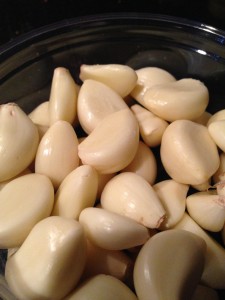The Golden Garlic
 If you have ever cooked with garlic before you’re probably familiar with its potent aroma and the way it carries on your hands and clothes for hours. And though the most delicious meals are cooked in garlic, as soon as you eat it, no amount of chewing gum or mouthwash can really take away that distinct smell.
If you have ever cooked with garlic before you’re probably familiar with its potent aroma and the way it carries on your hands and clothes for hours. And though the most delicious meals are cooked in garlic, as soon as you eat it, no amount of chewing gum or mouthwash can really take away that distinct smell.
But just because the aroma can be a tad powerful, that doesn’t mean you should avoid garlic. Most of the health benefits come from the sulfur compounds when garlic is chopped. These components are called allicin and this substance is also the source of that powerful aroma.
First, let me give you the breakdown about this common household food before I delve into its health benefits.
According to the definitions of herbs and spices, garlic really doesn’t fit into either of these categories. That’s why it’s most appropriate to call garlic a vegetable. It’s closely related to onions, shallots and leeks, which have similar recognizable flavors.
Garlic grows underground like many other root vegetables. The head (the edible portion) of the plant is called the bulb. Each segment of the bulb is called a clove. Cloves peel gracefully from the bulb but it may take you a while to remove its thin layers of skin.
Once you cut into the clove of the garlic, that’s when all of the health benefits come into play. Garlic is known for its moderate cardio protective attributes. It can lower your blood triglycerides as well as your cholesterol. Although it can only reduce them by 5-15%, that’s one good reason to add it to your healthy meals.
Garlic is also a great anti-inflammatory. Getting plenty of anti-inflammatory components in your food is crucial to your health. Every day your body is exposed to damage to your tissues one way or another by oxidative stress. When there is oxidative stress in your heart, it makes it easier for plaque to build on the surface of your vessels. In other body tissues, oxidative inflammation can cause joint pain similar to arthritis.
For centuries, garlic most notably has been used as an anti-bacterial. When bacteria called Helicobacter pylori overgrows in your stomach, it can cause irritation and stomach ulcers. The disulfide factors in garlic have been shown to control the growth of this bacteria and others that can cause infections.
It probably isn’t the first food that comes to mind when you think of a vegetable but garlic certainly is one vegetable you should be pairing with others. The flavor is distinct and can add a little flare to any meal. Not to mention it can boost your health. Try garlic this week in some of your meals!
Your Turn to Take Action: Share your favorite garlic recipes in the comments below!


Leave a Reply
Want to join the discussion?Feel free to contribute!